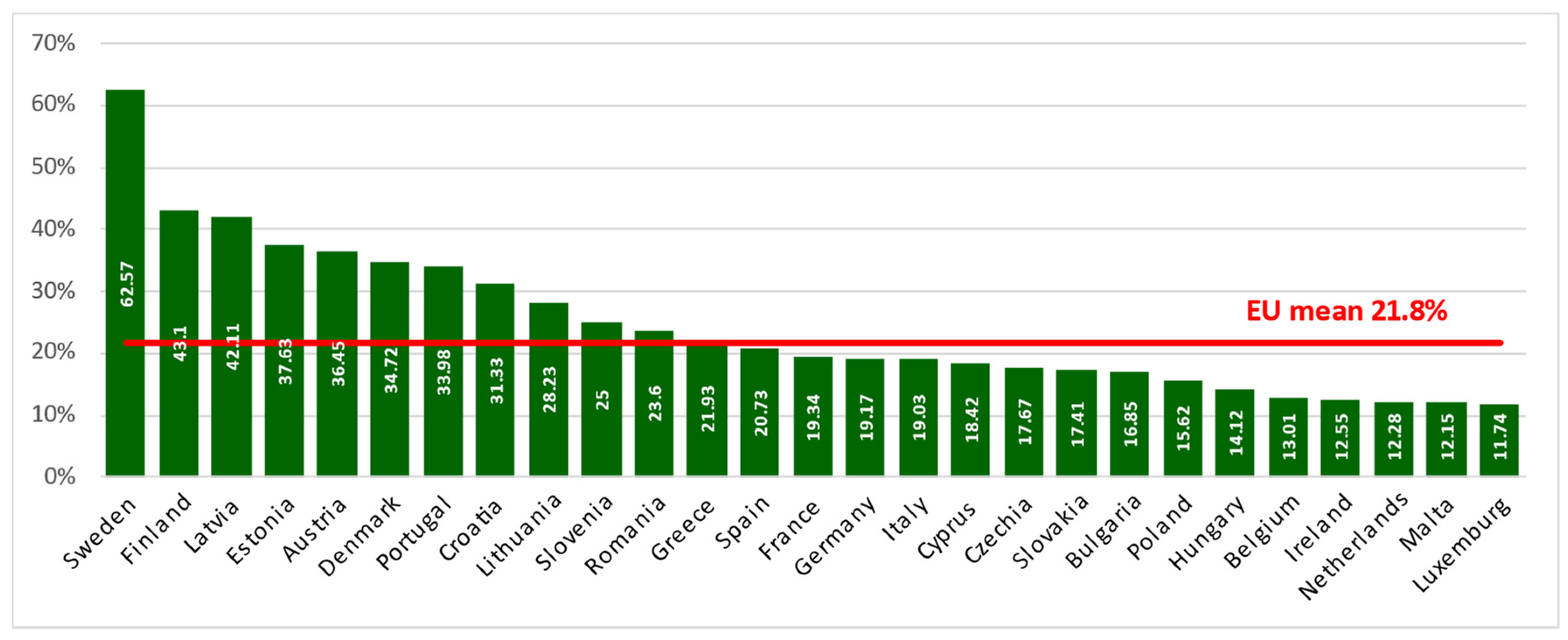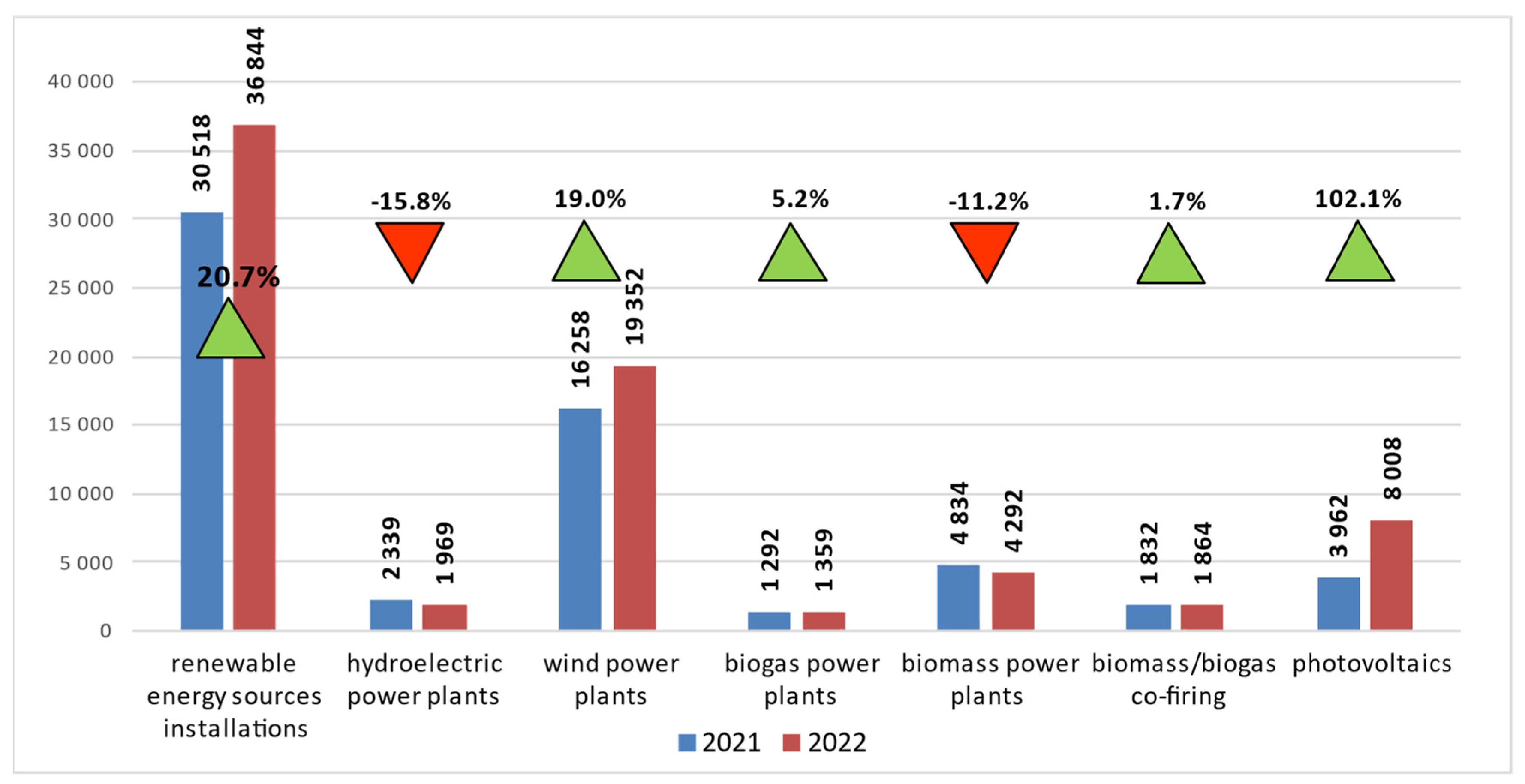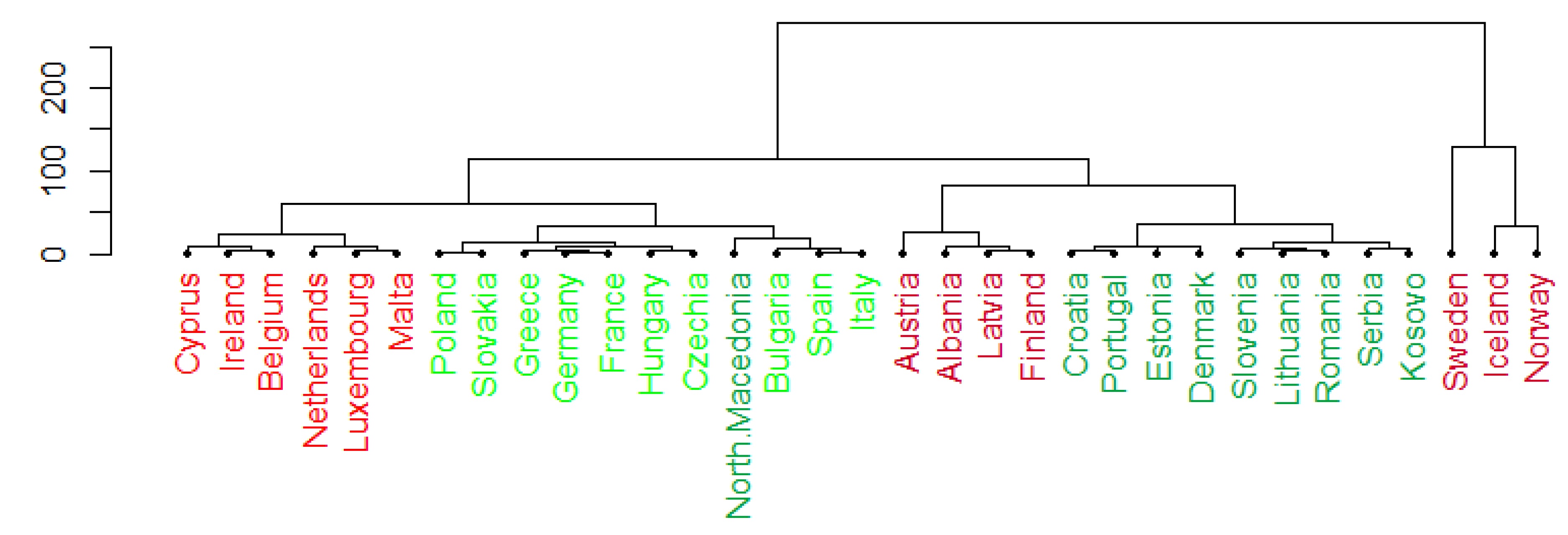Evaluating the Progress of Renewable Energy Sources in Poland: A Multidimensional Analysis
Abstract
:1. Introduction
- What is the current state of renewable energy sources in Poland?
- What are the barriers and challenges to renewable energy adoption in Poland?
- How does Poland’s progress in renewable energy compare to other countries or regions in the EU?
- What are the future prospects and potential for renewable energy in Poland?
2. Literature Review
2.1. Legal Framework for Energy Policy
2.2. Development of Renewable Energy Sources
3. Materials and Methods
- dla
- dla
4. Results
4.1. Share of Renewable Energy in Total Energy in EU Countries
- the share of RES was systematically growing,
- the differentiation of RES shares was systematically decreasing,
- the upward trend dominated the negative impact of the 2007–2009 crisis,
- the share of RES depended on the geographical location of the country,
- there was a similarity of short-term changes in RES shares of some neighbouring countries, but it was not a general rule.
4.2. Changes in RES in Poland
5. Discussion and Conclusions
Author Contributions
Funding
Data Availability Statement
Acknowledgments
Conflicts of Interest
Glossary
References
- Güney, T. Renewable energy, non-renewable energy and sustainable development. Int. J. Sustain. Dev. World Ecol. 2019, 26, 389–397. [Google Scholar] [CrossRef]
- Directive 2001/77/EC of European Parliament and of the Council of 27 September 2001 on the Promotion of Electricity Produced from Renewable Energy Sources in the Internal Electricity Market. Official Journal of the European Communities L.283/33. Available online: https://eur-lex.europa.eu/LexUriServ/LexUriServ.do?uri=OJ:L:2001:283:0033:0040:EN:PDF (accessed on 10 April 2023).
- Augutis, J.; Krikštolaitis, R.; Martišauskas, L.; Pečiulytė, S.; Žutautaitė, I. Integrated energy security assessment. Energy 2017, 138, 890–901. [Google Scholar] [CrossRef]
- Jezierska-Thöle, A.; Rudnicki, R.; Wiśniewski, Ł.; Gwiaździńska-Goraj, M.; Biczkowski, M. The Agri-Environment-Climate Measure as an Element of the Bioeconomy in Poland—A Spatial Study. Agriculture 2021, 11, 110. [Google Scholar] [CrossRef]
- Wang, J.; Geng, L.; Ding, L.; Zhu, H.; Yurchenko, D. The state-of-the-art review on energy harvesting from flow-induced vibrations. Appl. Energy 2020, 267, 114902. [Google Scholar] [CrossRef]
- European Commission. A New Industrial Strategy for Europe. Communication from the Commission to the European Parliament, the European Council, the Council, the European Economic and Social Committee and the Committee of the Regions; European Commission: Brussels, Belgium, 2020; Volume 102. [Google Scholar]
- Directive 2009/28/EC of the European Parliament and of the Council of 23 April 2009 on the Promotion of the Use of Energy from Renewable Sources. Available online: https://eur-lex.europa.eu/legal-content/EN/ALL/?uri=celex%3A32009L0028 (accessed on 4 October 2021).
- Komisja Europejska. Ramy polityczne na okres 2020–2030 dotyczące klimatu i energii. In Komunikat Komisji do Parlamentu Europejskiego, Rady, Europejskiego Komitetu Ekonomiczno-Społecznego i Komitetu Regionów; Komisja Europejska: Bruksela, Belgium, 2014. [Google Scholar]
- Transforming Our World: The 2030 Agenda for Sustainable Development. Available online: https://www.unfpa.org/resources/transforming-our-world-2030-agenda-sustainable-development (accessed on 4 October 2021).
- Pietzcker, R.C.; Osorio, S.; Rodrigues, R. Tightening EU ETS targets in line with the European Green Deal: Impacts on the decarbonization of the EU power sector. Appl. Energy 2021, 293, 116914. [Google Scholar] [CrossRef]
- Juściński, J. Perspektywy rozwoju Odnawialnych Źródeł Energii (OZE) w Polsce do 2020 roku. In [W] Odnawialne Źródła Energii w Świetle Globalnego Kryzysu Energetycznego; Wybrane problemy, red. F. Krawiec. Wydawnictwo; Difin: Warszawa, Poland, 2010; Volume 38. [Google Scholar]
- Zabed, H.; Sahu, J.N.; Suely, A.; Boyce, A.N.; Faruq, G. Bioethanol production from renewable sources: Current perspectives and technological progress. Renew. Sustain. Energy Rev. 2017, 71, 475–501. [Google Scholar] [CrossRef]
- Komisja Europejska. Europejski Zielony Ład. In Aneks do Komunikatu Komisji do Parlamentu Europejskiego, Rady Europejskiej, Rady, Komitetu Ekonomiczno–Społecznego i Komitetu Regionów; Komisja Europejska: Bruksela, Belgium, 2019. [Google Scholar]
- Gawlik, L.; Mirowski, T. Strategic directions of development of the Polish power sector in the light of climate and energy policy of the European Union. Humanit. Soc. Sci. 2016, 23, 49–62. [Google Scholar] [CrossRef]
- Emodi, N.V.; Chaiechi, T.; Beg, A.R.A. The impact of climate variability and change on the energy system: A systematic scoping review. Sci. Total Environ. 2019, 676, 545–563. [Google Scholar] [CrossRef]
- Bednarczyk, J.L.; Brzozowska-Rup, K.; Luściński, S. Determinants of the energy development based on renewable energy sources in Poland. Energies 2021, 14, 6762. [Google Scholar] [CrossRef]
- Jezierska-Thöle, A.; Gwiaździńska-Goraj, M.; Dudzińska, M. Environmental, Social, and Economic Aspects of the Green Economy in Polish Rural Areas—A Spatial Analysis. Energies 2022, 15, 3332. [Google Scholar] [CrossRef]
- Fadly, D.; Fontes, F. Geographical proximity and renewable energy diffusion: An empirical approach. Energy Policy 2019, 129, 422–435. [Google Scholar] [CrossRef]
- Dogan, E.; Seker, F. The influence of real output, renewable and non-renewable energy, trade and financial development on carbon emissions in the top renewable energy countries. Renew. Sustain. Energy Rev. 2016, 60, 1074–1085. [Google Scholar] [CrossRef]
- Filimonova, I.V.; Nemov, V.Y.; Komarova, A.V.; Mishenin, M.V.; Kozhevin, V.D. Relationship of renewable energy consumption to economic, environmental and institutional factors in Europe. Energy Rep. 2021, 7 (Suppl. S5), 358–365. [Google Scholar] [CrossRef]
- Brozyna, J.; Mentel, G.; Ivanová, E.; Sorokin, G. Classification of Renewable Sources of Electricity in the Context of Sustainable Development of the New EU Member States. Energies 2019, 12, 2271. [Google Scholar] [CrossRef]
- Caruso, G.; Colantonio, E.; Gattone, S.A. Relationships between renewable energy consumption, social factors, and health: A panel vector auto regression analysis of a cluster of 12 EU countries. Sustainability 2020, 12, 2915. [Google Scholar] [CrossRef]
- Pacesila, M.; Burcea, G.S.; Colesca, S.E. Analysis of renewable energies in European Union. Renew. Sustain. Energy Rev. 2016, 56, 156–170. [Google Scholar] [CrossRef]
- Brodny, J.; Tutak, M. Assessing sustainable energy development in the central and eastern European countries and analyzing its diversity. Sci. Total Environ. 2021, 801, 149745. [Google Scholar] [CrossRef] [PubMed]
- Global Trends in Sustainable Energy Investment in 2009: Analysis of Trends and Issues in the Financing of Renewable Energy and Energy Efficiency, United Nations Environment Programme and New Energy Finance. 2009. Available online: https://digitallibrary.un.org/record/688855?ln=en (accessed on 10 April 2023).
- Van Vuuren, D.P.; Stehfest, E.; Gernaat, D.E.; Doelman, J.C.; van den Berg, M.; Harmsen, M.; De Boer, H.S.; Bouwman, L.F.; Daioglou, V.; Edelenbosch, O.Y.; et al. Energy, land-use and greenhouse gas emissions trajectories under a green growth paradigm. Glob. Environ. Change 2017, 42, 237–250. [Google Scholar] [CrossRef]
- Chudy-Laskowska, K.; Pisula, T.; Liana, M.; Vasa, L. Taxonomic Analysis of the Diversity in the Level of Wind Energy Development in European Union Countries. Energies 2020, 13, 4371. [Google Scholar] [CrossRef]
- Papież, M.; Śmiech, S.; Frodyma, K. Determinants of renewable energy development in the EU countries. A 20-year perspective. Renew. Sustain. Energy Rev. 2018, 91, 918–934. [Google Scholar] [CrossRef]
- Igliński, B.; Buczkowski, R.; Cichosz, M.; Piechota, G.; Kujawski, W.; Plaskacz, M. Renewable Energy production in the Zachodniopomorskie Voivodeship (Poland). Renew. Sustain. Energy Rev. 2013, 27, 768–777. [Google Scholar] [CrossRef]
- Igliński, B.; Buczkowski, R.; Iglińska, A.; Cichosz, M.; Plaskacz-Dziuba, M. SWOT analysis of the renewable energy sector in Poland: Case study of Wielkopolskie region. J. Power Technol. 2015, 2, 143–157. [Google Scholar]
- Igliński, B.; Skrzatek, M.; Kujawski, W.; Cichosz, M.; Buczkowski, R. SWOT analysis of renewable energy sector in Mazowieckie Voivodeship (Poland): Current progress, prospects and policy implications. Environ. Dev. Sustain. 2022, 24, 77–111. [Google Scholar] [CrossRef]
- Jezierska-Thöle, A.; Rudnicki, R.; Kluba, M. Development of energy crops cultivation for biomass production in Poland. Renew. Sustain. Energy Rev. 2016, 62, 534–545. [Google Scholar] [CrossRef]
- Polityka Energetyczna Polski do 2030 Roku; Ministerstwo Gospodarki: Warszawa, Poland, 2009.
- Lund, H. Renewable energy strategies for sustainable development. Energy 2007, 32, 912–919. [Google Scholar] [CrossRef]
- Gaigalis, V.; Katinas, V. Analysis of the renewable energy implementation and prediction prospects in compliance with the EU policy: A case of Lithuania. Renew. Energy 2020, 151, 1016–1027. [Google Scholar] [CrossRef]
- Hills, J.M.; Michalena, E. Renewable energy pioneers are threatened by EU policy reform. Renew. Energy 2017, 108, 26–36. [Google Scholar] [CrossRef]
- Hansson, L.; Nerhagen, L. Regulatory measurements in policy coordinated practices: The case of promoting renewable energy and cleaner transport in Sweden. Sustainability 2019, 11, 1687. [Google Scholar] [CrossRef]
- Wurster, S.; Hagemann, C. Expansion of renewable energy in federal settings: Austria, Belgium, and Germany in comparison. J. Environ. Dev. 2020, 29, 147–168. [Google Scholar] [CrossRef]
- Gullberg, A.T.; Ohlhorst, D.; Schreurs, M. Towards a low carbon energy future–Renewable energy cooperation between Germany and Norway. Renew. Energy 2014, 68, 216–222. [Google Scholar] [CrossRef]
- ec.europa.eu/Eurostat. Available online: https://ec.europa.eu/eurostat/statistics-explained/index.php?title=Renewable_energy_statistics (accessed on 10 April 2023).
- stat.gov.pl. Available online: https://stat.gov.pl/obszary-tematyczne/srodowisko-energia/energia/energia-ze-zrodel-odnawialnych-w-2021-roku,10,5.html (accessed on 30 April 2023).
- are.waw.pl (Energy Market Agency SA). Available online: https://www.are.waw.pl/badania-statystyczne/wynikowe-informacje-statystyczne#2022-rok (accessed on 1 February 2023).
- ure.gov.pl (Energy Regulatory Office). Available online: https://www.ure.gov.pl/pl/oze/potencjal-krajowy-oze/5753,Moc-zainstalowana-MW.html (accessed on 5 February 2023).
- swiatoze.pl. Available online: https://swiatoze.pl/oze-w-polsce-w-2022-roku-podsumowanie-rynku-odnawialnych-zrodel-energii-i-elektromobilnosci/ (accessed on 5 February 2023).
- cire.pl. Available online: https://www.cire.pl/artykuly/o-tym-sie-mowi/kiedy-zniesienie-zasady-10-h-rynek-liczy-na-przyspieszenie-prac-legislacyjnych- (accessed on 20 March 2023).
- swiatoze.pl. Available online: https://swiatoze.pl/kategoria/oze/energia-wiatrowa/ (accessed on 20 March 2023).
- swiatoze.pl. Available online: https://swiatoze.pl/kategoria/oze/biogazownia/ (accessed on 20 March 2023).
- Dincer, I. Renewable energy and sustainable development: A crucial review. Renew. Sustain. Energy Rev. 2000, 4, 157–175. [Google Scholar] [CrossRef]
- Wicki, L.; Pietrzykowski, R.; Kusz, D. Factors Determining the Development of Prosumer Photovoltaic Installations in Poland. Energies 2022, 15, 5897. [Google Scholar] [CrossRef]
- Ramsay, J.O.; Silverman, B.W. Functional Data Analysis; Springer: Berlin/Heidelberg, Germany, 2005. [Google Scholar]
- Sahri, Y.; Belkhier, Y.; Tamalouzt, S.; Ullah, N.; Shaw, R.N.; Chowdhury, M.S.; Techato, K. Energy Management System for Hybrid PV/Wind/Battery/Fuel Cell in Microgrid-Based Hydrogen and Economical Hybrid Battery/Super Capacitor Energy Storage. Energies 2021, 14, 5722. [Google Scholar] [CrossRef]
- Kapłan, R.; Kopacz, M. Economic Conditions for Developing Hydrogen Production Based on Coal Gasification with Carbon Capture and Storage in Poland. Energ. Electron. J. 2020, 13, 5074. [Google Scholar]
- Niekurzak, M. The Potential of Using Renewable Energy Sources in Poland Taking into Account the Economic and Ecological Conditions. Energies 2021, 14, 7525. [Google Scholar] [CrossRef]
- Directive 2009/28/EC of the European Parliament and of the Council of 23 April 2009 on the Promotion of the Use of Energy from Renewable Sources and Amending and Subsequently Repealing Directives 2001/77/EC and 2003/30/EC (Text with EEA Relevance). Available online: https://eur-lex.europa.eu/legal-content/PL/TXT/?uri=celex%3A32009L0028 (accessed on 15 May 2022).
- Sebi, C.; Vernay, A.L. Community renewable energy in France: The state of development and the way forward. Energy Policy 2020, 147, 111874. [Google Scholar] [CrossRef]
- Khan, M.A.H.; Bonifacio, S.; Clowes, J.; Foulds, A.; Holland, R.; Matthews, J.C.; Percival, C.J.; Shallcross, D.E. Investigation of biofuel as a potential renewable energy source. Atmosphere 2021, 12, 1289. [Google Scholar] [CrossRef]
- Ministry of State Assets, Polityka Energetyczna Polski do 2040 r.—Strategia Rozwoju Sektora Paliwowo-Energetycznego, Warsaw, Poland. 2019. Available online: https://www.gov.pl/web/aktywa-panstwowe/zaktualizowany-projekt-polityki-energetycznej-polski-do-2040-r (accessed on 13 May 2023).
- Shahzad, U. The need for renewable energy sources. Energy 2012, 2, 16–18. [Google Scholar]
- European Commission. Green Paper on Greenhouse Gas Emissions Trading within the European Union; COM (2000) 87 final; European Commission: Brussels, Belgium, 2000. [Google Scholar]
- Bórawski, P.; Wyszomierski, R.; Bełdycka-Bórawska, A.; Mickiewicz, B.; Kalinowska, B.; Dunn, J.W.; Rokicki, T. Development of Renewable Energy Sources in the European Union in the Context of Sustainable Development Policy. Energies 2022, 15, 1545. [Google Scholar] [CrossRef]
- Olkuski, T. Analiza struktury produkcji energii elektrycznej we Francji i w Polsce. Polityka Energetyczna–Energy Policy J. 2013, 16, 143–155. [Google Scholar]
- solarpowereurope.org. Available online: https://www.solarpowereurope.org/ (accessed on 5 July 2023).
- swiatoze.pl. Available online: https://swiatoze.pl/moj-prad-podsumowanie-wszystkich-edycji/ (accessed on 5 July 2023).
- Communication from the Commission to the European Parliament, the Council, the European Economic and Social Commit-tee, and the Committee of Regions, Second Strategic Energy Review: An EU Energy Security and Solidarity Action Plan; COM (2008) 781 final; European Commission: Brussels, Belgium, 2008.
- Renewables in Global Energy Supply. An IEA Fact Sheet; International Energy Agency: Paris, France, 2002.
- energia.edu.pl. Available online: https://energia.edu.pl/energetyka-oparta-na-oze-wyzwania-i-perspektywy-w-nadchodzacych-latach/ (accessed on 5 July 2023).
- Zielonka, P.; Białaszek, W.; Dzik, B.; Wybrańczyk, K. How miners and other professional groups perceive the benefits and risks of hard coal mining: A study on the role of the affect heuristic. Front. Psychol. 2021, 12, 656960. [Google Scholar] [CrossRef] [PubMed]















| Total Prosumers of Renewable Energy | January–December | Dynamic Index (%) | ||
|---|---|---|---|---|
| 2021 | 2022 | |||
| MWh | ||||
| 2,670,208.7 | 5,534,767.5 | 207.3 | ||
| of which: | hydro | 1856.9 | 1795.6 | 96.7 |
| wind | 88.7 | 137.3 | 154.9 | |
| photovoltaic (PV) | 2,667,546.9 | 5,531,458.3 | 207.4 | |
| hybrid | 269.1 | 386.9 | 143.8 | |
| biogas | 339.6 | 792.3 | 233.3 | |
| biomass | 107.6 | 197.1 | 183.2 | |
Disclaimer/Publisher’s Note: The statements, opinions and data contained in all publications are solely those of the individual author(s) and contributor(s) and not of MDPI and/or the editor(s). MDPI and/or the editor(s) disclaim responsibility for any injury to people or property resulting from any ideas, methods, instructions or products referred to in the content. |
© 2023 by the authors. Licensee MDPI, Basel, Switzerland. This article is an open access article distributed under the terms and conditions of the Creative Commons Attribution (CC BY) license (https://creativecommons.org/licenses/by/4.0/).
Share and Cite
Jaworski, S.; Chrzanowska, M.; Zielińska-Sitkiewicz, M.; Pietrzykowski, R.; Jezierska-Thöle, A.; Zielonka, P. Evaluating the Progress of Renewable Energy Sources in Poland: A Multidimensional Analysis. Energies 2023, 16, 6431. https://doi.org/10.3390/en16186431
Jaworski S, Chrzanowska M, Zielińska-Sitkiewicz M, Pietrzykowski R, Jezierska-Thöle A, Zielonka P. Evaluating the Progress of Renewable Energy Sources in Poland: A Multidimensional Analysis. Energies. 2023; 16(18):6431. https://doi.org/10.3390/en16186431
Chicago/Turabian StyleJaworski, Stanisław, Mariola Chrzanowska, Monika Zielińska-Sitkiewicz, Robert Pietrzykowski, Aleksandra Jezierska-Thöle, and Piotr Zielonka. 2023. "Evaluating the Progress of Renewable Energy Sources in Poland: A Multidimensional Analysis" Energies 16, no. 18: 6431. https://doi.org/10.3390/en16186431
APA StyleJaworski, S., Chrzanowska, M., Zielińska-Sitkiewicz, M., Pietrzykowski, R., Jezierska-Thöle, A., & Zielonka, P. (2023). Evaluating the Progress of Renewable Energy Sources in Poland: A Multidimensional Analysis. Energies, 16(18), 6431. https://doi.org/10.3390/en16186431








